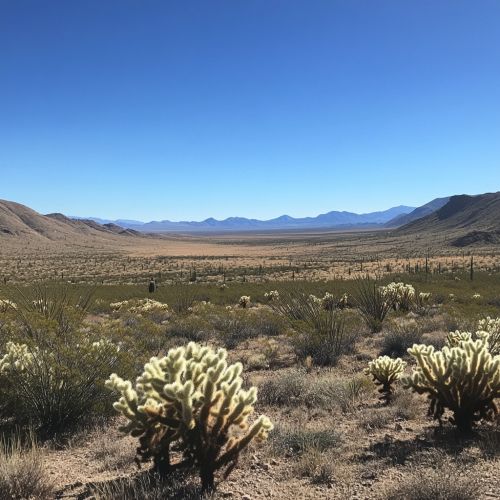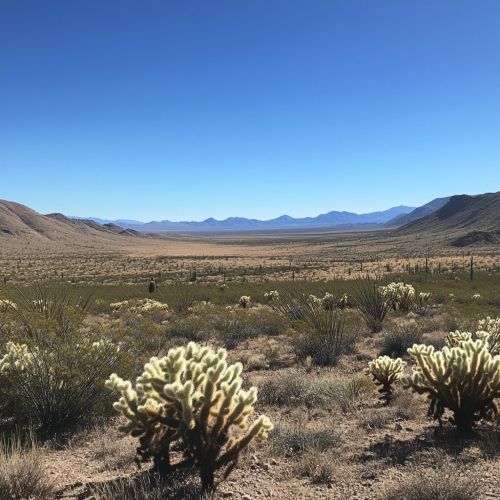Southwest United States
Geography and Climate
The Southwest United States is a distinct region characterized by its unique geography and climate. This region typically includes the states of Arizona, New Mexico, Oklahoma, Texas, and parts of California, Colorado, Nevada, and Utah. The area is known for its arid to semi-arid climate, with vast deserts such as the Sonoran Desert and the Chihuahuan Desert.
The climate in the Southwest varies significantly, with hot summers and mild winters being the norm in the lower elevations, while the higher elevations experience cooler temperatures and more precipitation. The Mojave Desert, for example, is one of the hottest and driest places in North America, while the Colorado Plateau features a more temperate climate with significant snowfall in the winter months.


History
The history of the Southwest United States is rich and diverse, shaped by various indigenous cultures, European colonization, and subsequent American expansion. Indigenous peoples such as the Navajo, Apache, Pueblo, and Hopi have inhabited the region for thousands of years, developing complex societies and cultures.
The arrival of Spanish explorers in the 16th century marked the beginning of European influence in the region. The establishment of missions, such as those in California and New Mexico, played a significant role in the spread of Christianity and European culture. The region was later claimed by Mexico following its independence from Spain in 1821, and eventually became part of the United States after the Mexican-American War and the Treaty of Guadalupe Hidalgo in 1848.
Demographics
The Southwest United States is known for its diverse population, which includes a significant number of Hispanic and Latino residents, as well as Native American communities. The region's demographic composition has been influenced by historical migration patterns, economic opportunities, and cultural exchanges.
According to the latest census data, the population of the Southwest is growing rapidly, particularly in urban areas such as Phoenix, Las Vegas, and Dallas. This growth is driven by factors such as a favorable climate, economic opportunities, and a relatively low cost of living compared to other parts of the United States.
Economy
The economy of the Southwest United States is diverse and robust, with key industries including agriculture, energy, technology, and tourism. The region is a major producer of crops such as cotton, citrus fruits, and pecans, thanks to its favorable climate and extensive irrigation systems.
The energy sector is also a significant contributor to the region's economy, with vast reserves of oil, natural gas, and coal. Texas, in particular, is a leading producer of oil and natural gas, while New Mexico and Arizona have substantial mining operations for minerals such as copper and uranium.
The technology industry has seen substantial growth in the Southwest, with cities like Austin and Phoenix becoming hubs for tech companies and startups. The region's relatively low cost of living and business-friendly environment have attracted numerous tech firms and skilled professionals.
Tourism is another vital component of the Southwest's economy, with attractions such as the Grand Canyon, Las Vegas Strip, and numerous national parks drawing millions of visitors each year. The region's rich cultural heritage, diverse landscapes, and recreational opportunities make it a popular destination for domestic and international tourists alike.
Culture
The culture of the Southwest United States is a vibrant blend of indigenous, Hispanic, and Anglo influences. This cultural diversity is reflected in the region's art, cuisine, music, and festivals.
Indigenous art and crafts, such as Navajo weaving and Pueblo pottery, are highly valued and widely recognized. Hispanic influences are evident in the region's architecture, with adobe buildings and Spanish missions being prominent features. The cuisine of the Southwest is known for its bold flavors and use of ingredients such as chili peppers, corn, and beans, with dishes like enchiladas, tamales, and chili con carne being popular staples.
Music and dance are also integral to the cultural fabric of the Southwest, with genres such as mariachi, Tejano, and country music being widely enjoyed. Festivals and events, such as the Albuquerque International Balloon Fiesta and the Texas State Fair, celebrate the region's unique heritage and attract visitors from around the world.
Environment and Conservation
The Southwest United States is home to a diverse array of ecosystems and wildlife, ranging from desert landscapes to mountainous regions. The region's unique environment faces several challenges, including water scarcity, habitat loss, and the impacts of climate change.
Water scarcity is a critical issue in the Southwest, with the Colorado River being a vital water source for millions of people and numerous agricultural operations. Efforts to manage and conserve water resources are ongoing, with initiatives such as the Central Arizona Project and various state-level water management plans being implemented to address the region's water needs.
Conservation efforts in the Southwest focus on protecting the region's unique habitats and species. National parks and protected areas, such as the Grand Canyon National Park, Saguaro National Park, and Big Bend National Park, play a crucial role in preserving the region's natural beauty and biodiversity. Additionally, organizations such as the Nature Conservancy and various state wildlife agencies work to protect endangered species and restore degraded habitats.
Transportation
The transportation infrastructure in the Southwest United States is well-developed, with an extensive network of highways, railroads, and airports facilitating the movement of people and goods. Major interstate highways, such as Interstate 10, Interstate 40, and Interstate 35, connect the region to other parts of the country and support economic activities.
Rail transportation is also significant in the Southwest, with freight railroads playing a crucial role in transporting goods such as agricultural products, minerals, and manufactured goods. Passenger rail services, such as Amtrak's Sunset Limited and Texas Eagle routes, provide connectivity between major cities in the region and beyond.
Air travel is a vital component of the region's transportation network, with major airports such as Phoenix Sky Harbor International Airport, Dallas/Fort Worth International Airport, and Las Vegas McCarran International Airport serving as key hubs for domestic and international flights.
Education
The Southwest United States is home to numerous institutions of higher education, including major research universities, community colleges, and technical schools. Prominent universities in the region include the University of Texas at Austin, Arizona State University, University of New Mexico, and University of Arizona.
These institutions play a crucial role in driving innovation, conducting research, and providing education and training to the region's workforce. The presence of major universities also contributes to the region's economic development, attracting businesses and industries that seek to collaborate with academic institutions and benefit from a skilled labor pool.
